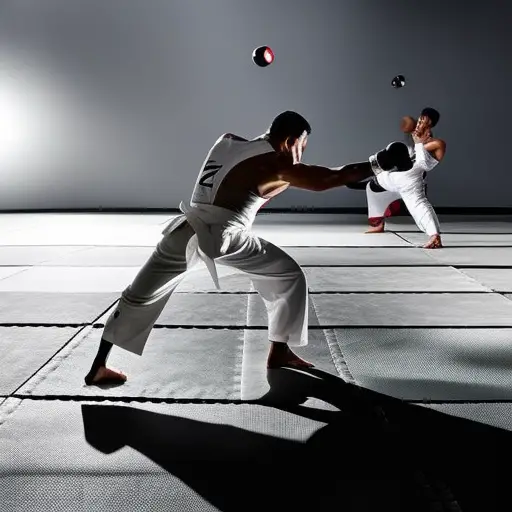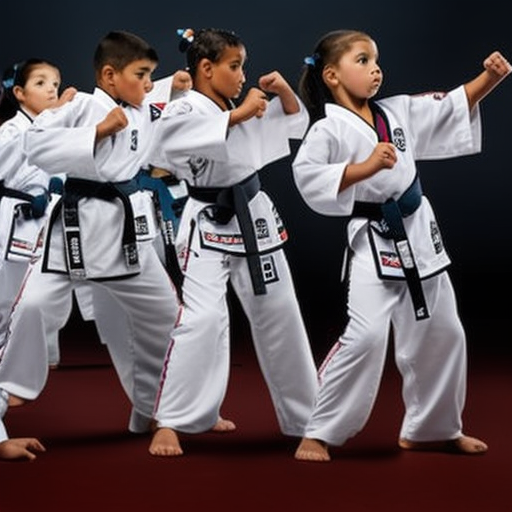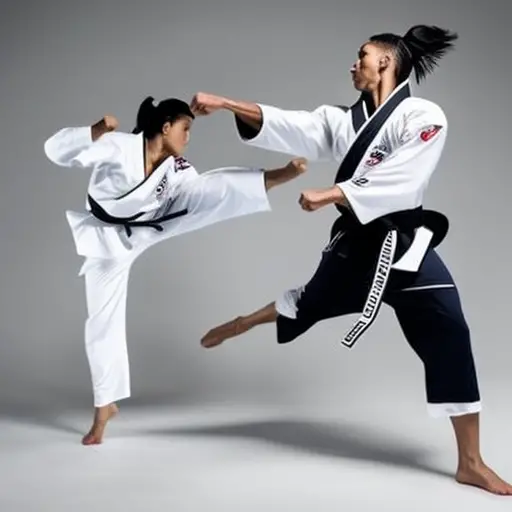How Taekwondo Differs From Other Martial Arts

Taekwondo, the art of kicking and punching, stands out from other martial arts with its unique combination of speed, power, and precision. Originating in Korea, Taekwondo is renowned for its explosive kicks and dynamic movements.
In this article, we will explore the distinguishing features of Taekwondo, including its rich history, training methods, philosophical principles, competition format, and belt ranking system.
Prepare to delve into the world of Taekwondo and discover what sets it apart from other martial arts.
History and Origins
The rich and intricate history of Taekwondo can be traced back over 2,000 years. Its origins can be found in ancient Korean martial arts, known as Subak, which were developed during the Three Kingdoms period. Subak was not only a method of self-defense but also held cultural significance, as it was used to train warriors and promote discipline and honor.
Over time, Subak evolved and incorporated influences from various martial arts techniques and philosophies. In the 20th century, Taekwondo as we know it today began to take shape, with the establishment of formal organizations and the standardization of techniques and training methods. The Korean government also played a pivotal role in promoting Taekwondo as the national martial art.
Today, Taekwondo has a global presence and is practiced by millions of people worldwide. It has influenced popular culture through its inclusion in movies, television shows, and sports events. Its dynamic kicks, powerful strikes, and acrobatic movements have captivated audiences and inspired many to take up the art.
Taekwondo has also been featured in the Olympic Games since 2000, further solidifying its place in the sporting world.
The cultural significance and influence of Taekwondo on popular culture cannot be overstated. Its centuries-old history and evolution have shaped it into a respected martial art that continues to inspire and impact people around the world.
Techniques and Training Methods
While Taekwondo shares some similarities with other martial arts, such as karate and kung fu, it stands apart due to its unique techniques and training methods. One of the distinguishing features of Taekwondo is its emphasis on high, fast kicks, which are executed with precision and power. These kicks require exceptional flexibility and control, and they are a key component of Taekwondo’s offensive and defensive strategies.
In addition to the emphasis on kicks, Taekwondo also incorporates a variety of hand strikes, punches, and blocks. However, it is the use of the legs that truly sets Taekwondo apart from other martial arts. The practitioners of Taekwondo are known for their ability to execute dynamic and acrobatic kicks, making it a visually striking martial art.
When it comes to training methods, Taekwondo places a strong emphasis on sparring techniques. Sparring allows practitioners to apply their skills in a controlled environment, testing their abilities and developing their timing, speed, and accuracy. It also helps improve their ability to read and react to their opponent’s movements.
Furthermore, Taekwondo incorporates a variety of conditioning exercises to enhance the physical fitness of its practitioners. These exercises include strength training, cardiovascular workouts, and flexibility training, all of which play a crucial role in developing the speed, power, and endurance required for effective Taekwondo techniques.
Philosophy and Mindset
Taekwondo practitioners cultivate a disciplined mindset and embrace a philosophy that emphasizes respect, self-control, and perseverance. The mental resilience and discipline developed in Taekwondo can be attributed to its philosophy and mindset. Taekwondo not only focuses on physical techniques but also on the mind-body connection.
In Taekwondo, the mind is considered just as important as the body. Practitioners are taught to develop mental strength and resilience through rigorous training. This mental resilience allows them to face challenges and overcome obstacles both on and off the mat. The discipline instilled in Taekwondo practitioners helps them to stay focused and committed to their goals, even in the face of adversity.
The philosophy of Taekwondo also emphasizes the mind-body connection. Practitioners are taught to be aware of their thoughts, emotions, and physical sensations during training. This heightened awareness allows them to better control their movements and reactions, improving their overall performance. By focusing on the mind-body connection, Taekwondo practitioners are able to achieve a state of harmony and balance.
Competitions and Scoring System
One key aspect that distinguishes Taekwondo from other martial arts is its unique scoring system used in competitions. In Taekwondo competitions, scoring is based on a set of criteria that focus on specific techniques and strikes. These scoring criteria include precision, power, control, and effectiveness of the techniques performed. Different techniques are assigned different point values, with more difficult and impactful moves earning higher scores.
The scoring system in Taekwondo competitions can vary depending on the rules and regulations of the specific event. For example, in Olympic-style Taekwondo, competitors score points by landing kicks to the trunk or head of their opponents. These kicks must be delivered with sufficient force and control to be considered valid. In other variations of Taekwondo, additional techniques such as punches and sweeps may also be allowed, each with their own scoring criteria.
The unique scoring system in Taekwondo competitions adds excitement and strategy to the sport. It requires competitors to not only demonstrate technical skill and athleticism but also to strategize and adapt their techniques based on the scoring criteria. This makes Taekwondo competitions a dynamic and engaging spectator sport.
Transition: Now that we have discussed the scoring system in Taekwondo competitions, let’s move on to explore the next aspect that sets Taekwondo apart from other martial arts: the uniforms and belt ranking system.
Uniforms and Belt Ranking System
The belt ranking system in Taekwondo signifies a practitioner’s progression and mastery of the martial art. It holds a deep cultural significance and has evolved over time to represent various levels of skill and expertise.
-
Cultural significance:
-
The belt ranking system in Taekwondo reflects the values and traditions of Korean culture, emphasizing discipline, respect, and perseverance.
-
It serves as a reminder of the martial art’s roots and the importance of maintaining its traditional practices.
-
The colored belts worn by practitioners also symbolize the different stages of growth and development in their Taekwondo journey.
-
Evolution over time:
-
The belt ranking system in Taekwondo has evolved from a simple white belt to a comprehensive system of colored belts, each representing a specific level of proficiency.
-
The system was introduced in the 1950s and has since been refined to establish clear guidelines for practitioners to progress and set goals.
-
The inclusion of colored belts allows for a more structured and organized approach to training, providing motivation and a sense of achievement as practitioners advance through the ranks.
The uniforms and belt ranking system in Taekwondo play a vital role in shaping the martial art’s identity. They embody cultural significance and have evolved over time to create a structured path for practitioners to follow, reflecting their progress and mastery of the art.
Frequently Asked Questions
Are There Any Age Restrictions for Practicing Taekwondo?
There are no age restrictions for practicing taekwondo as it offers numerous benefits for individuals of all ages. Common misconceptions about age restrictions in taekwondo should be addressed to encourage participation at a young age.
How Long Does It Take to Earn a Black Belt in Taekwondo?
The average duration to earn a black belt in Taekwondo can vary depending on various factors such as the intensity of training, individual dedication, and skill level. It typically takes several years of consistent practice and effort to achieve this milestone.
Can Someone With No Prior Martial Arts Experience Start Learning Taekwondo?
Learning taekwondo without prior experience offers a transformative journey, fostering mental well-being while developing physical strength and discipline. With professional guidance, individuals can embark on this martial art, reaping its numerous benefits.
Is Taekwondo More Focused on Kicking Techniques Compared to Other Martial Arts?
Taekwondo places a strong emphasis on kicking techniques and their application in self-defense situations. The art’s focus on powerful and precise kicks distinguishes it from other martial arts, highlighting its unique approach to combat.
Are There Any Health Benefits Associated With Practicing Taekwondo?
Practicing Taekwondo offers numerous health benefits, including improved physical fitness and overall well-being. This ancient martial art combines rigorous training, flexibility, and cardiovascular exercise, making it an excellent choice for those seeking to enhance their health and fitness levels.
Conclusion
In conclusion, taekwondo stands apart from other martial arts with its rich history, unique techniques, and distinctive philosophy. The sport’s emphasis on high kicks and dynamic movements sets it apart, as does its focus on discipline and self-control.
Taekwondo’s scoring system, uniforms, and belt ranking system also contribute to its distinct identity. Through its combination of physical prowess and mental fortitude, taekwondo offers a holistic approach to martial arts training.





